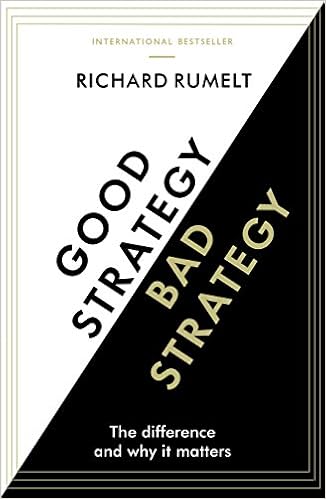 I thought I remembered my friend Art Petty saying that he liked Good Strategy Bad Strategy: The Difference and Why It Matters by Richard Rumelt. So, I emailed him and asked if that was true. Here’s his reply.
I thought I remembered my friend Art Petty saying that he liked Good Strategy Bad Strategy: The Difference and Why It Matters by Richard Rumelt. So, I emailed him and asked if that was true. Here’s his reply.
“Like is an understatement. Rumelt’s kernel of Strategy is the most powerful, supple approach for creating clarity and coherence on strategy I’ve yet encountered.”
Art’s no novice. He’s been an effective executive and an effective consultant for decades. He works with clients on strategy. And, guess what? The book lived up to Art’s recommendation and then some.
The kernel of Strategy that Art referred to is a great reason to read the book, even if that’s all you get out of it. Here’s Rumelt’s description of the kernel.
“A good strategy has an essential logical structure that I call the kernel. The kernel of a strategy contains three elements: a diagnosis, a guiding policy, and coherent action. The guiding policy specifies the approach to dealing with the obstacles called out in the diagnosis. It is like a signpost, marking the direction forward but not defining the details of the trip. Coherent actions are feasible coordinated policies, resource commitments, and actions designed to carry out the guiding policy”.
The kernel isn’t a magic formula. It’s a guide to the most important hard work you will do to create a strategy. If you’re a consultant, it’s a quick way to help you figure out if your client has a strategy or not. As Rumelt points out in the book, a lot of things masquerade as strategy. Plans and slogans and goals can look like strategy until you analyze them with a tool like the kernel.
What makes creating a great strategy hard is that it involves choices, and we don’t like choices. We also don’t like hard work, so we skip the hard parts and just do the parts that are fun.
In my experience, an awful lot of companies spend a day or so developing their strategy. They substitute discussion for diagnosis. Talk replaces analysis. Then they trot out some fine-sounding generalities instead of taking time to craft guiding principles. Biz-speak often replaces clear language here. There’s a lot of talk about what to do, but precious little about how to coordinate activities.
Most of those companies spend most of their time on what they’re going to do, after skipping the hard parts of diagnosis and guiding principles. Art says that, since reading Rumelt, he spends more time on the strategy process. He spends half of the time on diagnosis, another 40 percent on what Rumelt calls the guiding philosophy, and 10 percent on coherent actions. It’s much harder to do it that way than it is to go off to an offsite and whip up some generalities that sound good but don’t have much impact on day-to-day work life.
Here’s what it comes down to. The kernel is the way you develop a good strategy. The kernel is also the way that you identify bad strategy, whether it’s yours or someone else’s. Now that I’ve read this book, I won’t think about doing strategy the same way ever again. Rumelt has helped me know some danger signals to watch for. And he’s given me a language for guiding the process of creating and evaluating a strategy.
The kernel is reason enough to buy and read this book, but there are lots of other goodies here, too. There’s analysis of many business situations that I found both absorbing and compelling.
There’s one other thing you can take away from this book. Even when you do the work to create and execute a good strategy, you can still not succeed. You can make bad choices, even with a good process. Luck still plays a role. Unforeseen events play a role. The competition plays a role.
This book was written in 2006. Rumelt makes several predictions about how some things will play out in the years ahead. He gets some of them right, some of them wrong, and some of them a mix of both. That’s a good thing because it demonstrates what’s true in real life. There are times when you can do everything wrong and have things turn out right. And there are times when you can do everything right and still go down in flames.
One of my favorite quotes about life is from the American writer and horseplayer, Damon Runyon. It goes like this: “The race may not always be to the swift, nor victory to the strong, but that’s the way you bet.” Developing a good strategy is the hard work of figuring out how to bet.
In A Nutshell
Good Strategy Bad Strategy: The Difference and Why It Matters by Richard Rumelt gives you a roadmap that will help you develop better strategy. Ironically, that will make your work harder. Thankfully, it will also increase your odds of success.
You can check out some of my highlights and notes from this book on my GoodReads page.
-o0o-
What’s the fastest way to learn the big ideas from a great business book? Book summaries. Check out summaries from The Business Source, where you can watch, read, or listen to the big ideas from a great book in under 20 minutes.


Hi, Wally! Thanks for the great synopsis of Good Strategy, Bad Strategy. I happen to know Art as well and know how valuable his recommendations are. The kernal concept is so simple yet powerful – the 10% of coherent actions made me raise my eyebrows! Now, I have to get this book! Thanks, Wally :)
Thanks for the kind words. Enjoy the book.